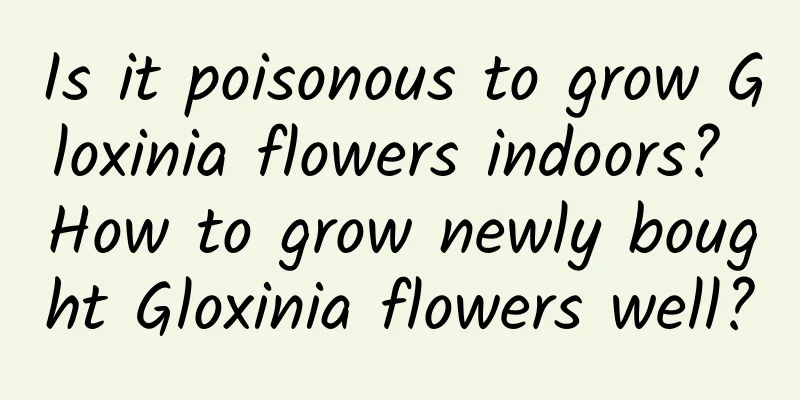Is it poisonous to grow Gloxinia flowers indoors? How to grow newly bought Gloxinia flowers well?

|
Gloxinia flowers are a common flower plant in our lives. Because of their elegant flowers and their ability to purify the air, they are the first choice of many flower growers. However, since many flowers are slightly toxic, where to grow them becomes a big problem. Let's take a look. Is it poisonous to grow Gloxinia flowers indoors?Growing Gloxinia flowers indoors is not toxic. Not only is it non-toxic, it can also purify the air and has great ornamental value, so many people grow Gloxinia flowers. If Gloxinia flowers are grown indoors, then during normal maintenance, it is necessary to ensure that their living environment is moist. Moreover, Gloxinia flowers have poor cold resistance, so they must be grown indoors in winter and maintained at a temperature of around 20 degrees Celsius, otherwise the low temperature will affect the flowering of the plants. How to take care of newly bought Gloxinia flowers1. LightingGloxinia prefers a semi-shady environment and is afraid of strong sunlight. It can be placed in a bright place or a place with scattered light, but I personally think it is better to place it in a sunny place and provide appropriate shade when the light is too strong. If there is insufficient light or too much shade, the leaves of Gloxinia will droop and the flower color will fade. 2. TemperatureGloxinia is not heat-resistant in summer and cold-resistant in winter. Pay attention to ventilation in summer and keep warm in winter. The planting temperature should not be lower than 5℃ to avoid frost damage. 3. WateringGloxinia likes moisture, but is afraid of waterlogging. After entering autumn, control the amount of watering. In winter, when the temperature drops, keep the soil slightly moist. When watering, be careful not to drip on the leaves, which can easily cause leaf rot. Lift the leaves and water along the edge of the pot. When the air is dry, you can spray the surrounding environment. 4. FertilizationAfter flowering, add a low-concentration fertilizer solution to promote new flower stems. When fertilizing, be careful not to let the fertilizer drip on the leaves. 5. PruningIf there are yellow leaves or withered flowers, they should be cut off in time to save nutrients and promote the growth of Gloxinia. 6. RepottingGloxinia generally needs to be repotted once a year. If it is not repotted in spring, the potting soil can be replaced after flowering to refresh the soil. The soil can be a mixture of leaf mold, garden soil and river sand. 7. Pest and disease controlLeaf blight nematode disease is common in Gloxinia. The diseased plants should be cleaned up in time and the soil should be disinfected to prevent the spread of the disease. Red spider mites are prone to infestation in high temperature environments. Spray omethoate emulsifiable concentrate solution to kill insects. Can Gloxinia flowers be placed in the bedroom?Because flowers with open flowers like Gloxinia also need to breathe, they need to absorb oxygen and release carbon dioxide at night. If your bedroom is small and relatively closed, it will have a certain impact on the human body. Over a long period of time, it will affect people's sleep problems and cause physical discomfort. Therefore, it is not recommended to place Gloxinia flowers in the bedroom. You can place it in the living room, which can not only purify the air but also decorate the home. Can Gloxinia flowers survive by leaf cutting?After the flowers fall, select excellent individual plants, cut off the strong leaves, leaving 1 cm of petiole, and insert them obliquely into clean river sand (it will be better if a matrix soil mixed with perlite and vermiculite is used). 1/3 of the leaf surface is inserted in the river sand, and 2/3 remains on the ground surface. Provide appropriate shade and maintain a certain humidity. At a temperature of about 22°C, it will take root in 15 days, and the seedlings can be transplanted into small pots. |
>>: How to mix seeds for peanuts to prevent insects? How to add water to mix seeds for peanuts?
Recommend
Can gynecological BV positive heal itself?
Some women went to the hospital to check their se...
Where are roses distributed? What colors do roses come in?
Rose is also known as Changchun rose, Yueyuehong,...
A growling stomach doesn’t necessarily mean you’re hungry; it could be a warning from your body…
Friends There must have been such a situation. Yo...
Is the ovulation date fixed every month?
Generally speaking, for healthy women, the ovulat...
What to do if women have high estrogen levels
Men's bodies contain male hormones, and women...
Maintaining healthy indicators can extend life! Tongji Medical College Research
There are seven indicators for assessing cardiova...
The harm of labia long granules
The labia is a private area of women, but it is...
What is the cause of abnormal vaginal discharge and vaginal itching?
The main symptoms of vulvovaginal candidiasis and...
How to treat early vaginitis in pregnant women
Vaginitis is one of the common gynecological dise...
Why is the leucorrhea bloody?
Some women's leucorrhea may contain blood and...
What if there is blood on my underwear but I haven’t had my period?
Many women have experienced this situation in the...
What to do with uterine fibroid pain? TCM has a folk remedy
Uterine fibroids are a relatively common female u...
How to deal with the salesperson when buying a car Why do 4S stores like to recommend installment purchases
Many people always encounter some problems when b...
Right ovarian enlargement
Right ovarian cyst refers to ovarian cyst, and ri...
Prevention of uterine rupture
The uterus is a relatively important issue for wo...









